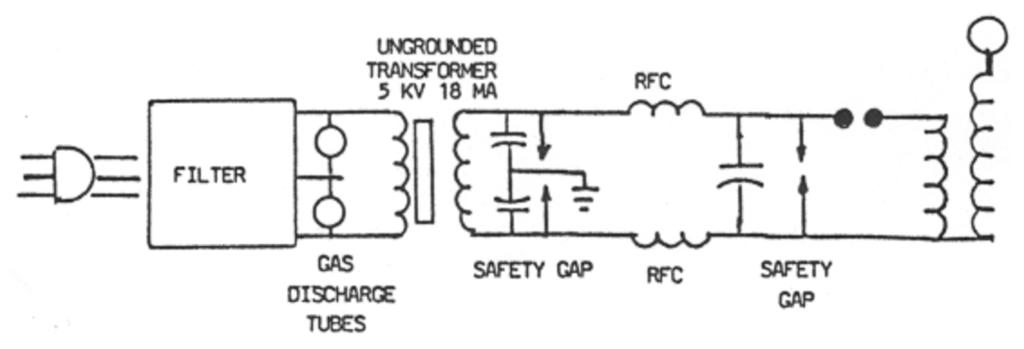TCBA Volume 11 - Issue 1
Page 7 of 18
Input - Output
Q. Has there been any documented cases of serious ill-effects from the use of “Violet Ray” devices?
A. Although I own a number of books which cover the use of violet ray units in treating diseases, I have no medical data to show that the machines had any detrimental effects. Oh yes, I suppose that there have been those who were foolish enough to play around with the innards of a violet ray while it was energized (count me among them). And, there may have been a few electrocutions where someone decided to sit in a bath while taking a violet ray treatment (yeow!). Other than the above speculations, I have no answer to your question.
Q. Is there any way I can determine if my 15 kilovolt neon sign transformer is providing its full voltage?
A. There are two ways to check the output voltage of a high voltage transformer. One is by actual measurement with test equipment and the other is by guesstimation.
- The actual voltage can be measured using a volt-ohmmeter (VOM) or vacuum tube voltmeter (VTVM). You will also need a high voltage probe. Most probes are rated for DC voltages but you can measure AC voltages as long as you don't exceed, say, 70% of the DC rating. A probe rated at 40 kilovolts DC can be used to measure up to 28 kilovolts AC. I use a Simpson 50 kv DC probe connected to a Radio Shack VOM. Ten kilovolts reads 1 volt on the meter. A reading of 1.5 volts would correspond to 15 kilovolts AC.
It is advisable to carry out the measurement by taping or clamping the probe in place. That is, don't hold the probe in hand when taking measurements. I also recommend the use of a variac to bring the voltage up slowly. In this way, you will immediately know if there are any hitches before any damage can be done to the meter.
- The guesstimation method will not tell you the actual voltage but it can be used to find out if both sides of the transformer are producing equal voltage.
Attach a long lead to one of the high voltage terminals. Strip some insulation from the loose end of the wire. Now tape the loose end to a long insulated rod (PVC, plastic, etc.) Allow the bare end of the wire to extend an inch or so from the rod. While standing on an insulated platform or stand, take the free end of the insulated rod in hand (keep the other hand in your pocket or at your side) and bring the end of the loose wire close to the (grounded) transformer case. Have an assistant switch on the transformer. You should be able to draw an arc at 1/4" to 1/2" distance. Slowly increase the distance between the loose wire and the transformer. A full 7500 volt potential will allow you to extend the arc to about 1". Shut down the power and repeat the experiment with the other high voltage terminal. If both sides produce the same effect, then the transformer is probably meeting its rated potential.
WARNING! Working with high voltage devices involves the possibility of electric shock. Both methods described above require careful attention to safety. Don't work alone. Have an assistant present at all times.
Q. I have a problem with arcing at my transformer-protecting RFCs. These have windings spaced 1/4" apart. Silicone rubber helps but I wonder if taper-wound chokes would stop this. I've enclosed a schematic of my circuit.
A. There have been several references to the use of RF chokes in Tesla coil circuits carried in the NEWS. I recommend your reading D.C. Cox's “Protecting Your Investment” (Volume 5, #4, p.12) and Carl Noggle's “Radio Frequency Chokes in Tesla Coil Circuits” (Volume 9, #3, p.11).
As for the use of tapered chokes, it would seem to me that they would provide protection over a wider frequency but I am not convinced that they would correct the problem.
In regard to your circuit, you seem to have disregarded the use of a ground. Perhaps this is what is causing the arcing problem. I suggest that you ground the transformer case as well as the point where the primary and secondary of the Tesla coil are connected.
Q. I am in the process of setting up a demonstration of gaseous tubes excited by high frequency currents. Can you tell me what determines the degree of glow. Is there a frequency at which gases glow brighter?
A. As far as I know, frequency has little effect on the brightness. The intensity of glow is dependent on the vapors used, the pressure of the vapors, the diameter of the discharge column, and the current density.

